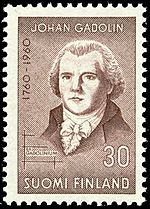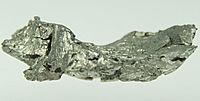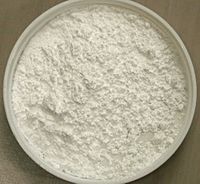Johan Gadolin facts for kids
Quick facts for kids
Johan Gadolin
|
|
|---|---|

Johan Gadolin
|
|
| Born | 5 June 1760 |
| Died | 15 August 1852 (aged 92) |
| Nationality | Finnish |
| Known for | Yttrium |
| Scientific career | |
| Fields | Chemistry |
Johan Gadolin (born June 5, 1760 – died August 15, 1852) was a famous Finnish scientist. He was a chemist, a physicist, and a mineralogist.
Gadolin discovered a "new earth" that contained the first rare-earth element compound, yttrium. This was later found to be a unique chemical element. He is also known as the person who started modern chemistry research in Finland. He held the second Chair of Chemistry at the Royal Academy of Turku. For his important work, Gadolin was made a nobleman. He also received special awards like the Order of Saint Vladimir and the Order of Saint Anna.
Contents
Early Life and Education
Johan Gadolin was born in Åbo, which is now called Turku, Finland. At that time, Finland was part of Sweden. His father, Jakob Gadolin, was a professor of physics and theology.
When Johan was fifteen, he started studying mathematics at the Royal Academy of Turku. Later, he changed his main subject to chemistry. He studied with Pehr Adrian Gadd, who was the first chemistry professor at Åbo.
In 1779, Gadolin moved to Uppsala University in Sweden. In 1781, he wrote his main paper, Dissertatio chemica de analysi ferri. This paper was about the chemical analysis of iron. His professor, Torbern Bergman, led an important research group. Many of Bergman's students, including Gadolin, became close friends.
Career as a Scientist
Gadolin was very good at languages. He could speak Latin, Finnish, Russian, German, English, and French. His native language was Swedish. In 1784, he wanted to become a chemistry professor at Uppsala, but another scientist was chosen.
In 1785, Gadolin became an unpaid professor at Åbo. Starting in 1786, he traveled around Europe to visit universities and mines. This trip helped him learn more about chemistry. He worked with famous scientists like Lorenz Florenz Friedrich von Crell in Germany. He also worked with Adair Crawford and Richard Kirwan in Ireland.
Gadolin became a member of the Royal Swedish Academy of Sciences in 1790. This was a great honor.
In 1797, Gadolin became the main professor of chemistry at the Royal Academy of Turku. He held this job until he retired in 1822. He was one of the first professors to let students do experiments in the lab. He even let them use his own private laboratory.
Important Chemistry Discoveries
Gadolin made many important contributions in different areas of chemistry.
Even though he never visited France, he supported Antoine Lavoisier's ideas about how things burn. Gadolin's book, Inledning till Chemien (1798), was the first chemistry textbook in the Nordic countries to question the old idea of phlogiston. It explained how oxygen helps things burn in a modern way.
Studies of Heat
Gadolin studied how heat relates to chemical changes. He looked at how much heat different substances could absorb. This is called specific heat. He also studied how much heat is absorbed when a substance changes its state, like ice melting into water. This is called latent heat.
His work on heat needed very careful measurements. Gadolin published important papers on specific heat by 1784. He also wrote about the latent heat of steam in 1791. He showed that the heat in ice was the same as the heat in snow. He also published a standard set of heat tables.
Yttrium: The First Rare-Earth Element
Gadolin became famous for describing the first rare-earth element, yttrium. In 1792, he received a sample of a heavy, black mineral. This mineral was found in a quarry in Ytterby, a Swedish village near Stockholm.
Gadolin did careful experiments on the sample. He found that about 38% of it was a new, unknown "earth." This oxide was later named yttria. Yttria, or yttrium oxide, was the first known rare-earth metal compound. At that time, it was not yet seen as a modern element. His discovery was published in 1794.
The mineral Gadolin studied was named gadolinite in 1800. Later, the element gadolinium and its oxide gadolinia were named after Gadolin by the scientists who discovered them.
In an earlier paper from 1788, Gadolin showed that the same element can exist in different forms. For example, tin can combine with different amounts of oxygen. He described a reaction where one form of tin changes into two other forms.
Analytical Chemistry
Gadolin figured out what Prussian blue was made of. He also suggested a way to separate iron from other substances. This was forty years before another scientist, Gay-Lussac, did similar work.
Many of Gadolin's chemistry studies were published in a German science journal. In 1825, he published a book called Systema fossilium. This book presented a way to classify minerals based on their chemical makeup.
One of Gadolin's last studies was about a Chinese metal alloy called pak tong. This was in 1810 and 1827. It was also known as alpacca or German silver. It was a cheaper substitute for silver. It often contained copper, zinc, nickel, and tin.
Gadolin is also known for creating one of the first condensers. In 1791, he improved a condenser design from his father. He used the "counter-current principle." This meant the cooling water flowed uphill, which made the condenser work better. This idea was later used by Justus Liebig in what is now called a Liebig condenser.
Awards and Honors
Gadolin was made a knight. His name is listed in the Finnish House of Nobility. He also received the Order of Saint Vladimir and the Order of Saint Anna. His family's special symbol was a shield with a blue stripe, two gold stars, a red rose, and crystals.
Later Life
Johan Gadolin first got married at age 35 to Hedvig Tihleman. They had nine children together. After his first wife died, he married Ebba Palander at age 59.
Gadolin retired as a professor in 1822 when he was 62 years old. This was the required retirement age. He moved to a country estate and lived there for another 30 years. He died in Mynämäki, Finland on August 15, 1852.
In 1827, a big fire, called the Great Fire of Turku, started in a bakery. It destroyed much of the town of Åbo. Gadolin's laboratory and his collection of minerals near the cathedral were also destroyed in the fire.
See also
 In Spanish: Johan Gadolin para niños
In Spanish: Johan Gadolin para niños




